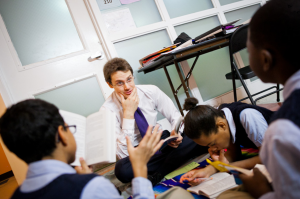02.14.14Clip of the Day: Jason Armstrong & the Whisper Correction (Video)
The Whisper Correction
Take a minute to watch this clip of Jason Armstrong’s math class at Roxbury Prep.
You’ll notice that Jason makes two corrections of students who are off task. Both of them are essentially public. He’s standing in front of the class when he makes them. But Jason makes them feel like private individual corrections because he whispers them. Essentially he gets the benefits of privacy—he messages “I am trying to do this without calling too much attention to you”—by creating the illusion of privacy. We call this a “whisper correction” and it’s one of our most useful new observations about 100% in TLaC 2.0. Even if you are standing in front of a classroom with 28 pairs of eyes on you, you can create many of the benefits of a private correction merely by dropping your voice into a whisper or, in fact, a stage whisper. Spoken aloud, “Roberta, I need you sitting up,” is a public judgment and invites a public response. Whispered, it is for her benefit alone, even if Roberta is in the back row and you are up front and you both know that everyone else heard it.


Cool. So there’s research now to support this as an effective technique for instruction?
this is a technique that Jason–a very high performing teacher–uses and that i have seen other outstsanding teachers use with great success. research can mean a lot of different things and i want to be careful about how i use that word. is THIS the thing that makes Jason successful? can i say that for sure? have I done a controlled experiment? I can’t say yes to any of those. i believe there’s evidence to support this based on a selection set and my observations thereof. definitely data driven. but informal by sceintific standards for sure and some people would not use the word “research” forthat while others might. I just want to be careful as to what i’m claiming .
You know the same can be done by streaming in the “correction” in exactly the same tone you are using while teaching. I find the response is great with kids (most times) because there is not a pause, a change in tone accompanied by a ‘look’, etc. It is an observation that is meted out in the same way content is.
Good reminder by way of example.
As a secondary teacher of nearly 3 decades, I find most classroom management techniques seem to always be applied or drawn from a primary school experience. Always looking for successful techniques that work with secondary students – seems they are a lot rarer!